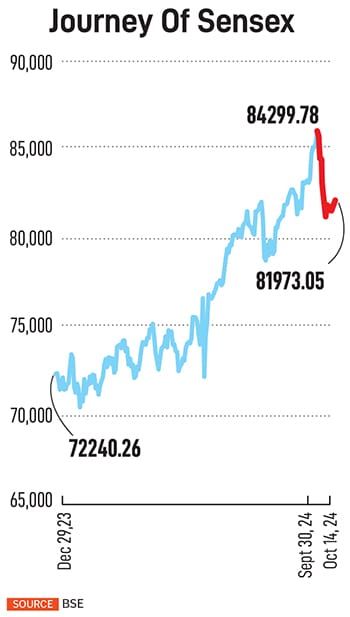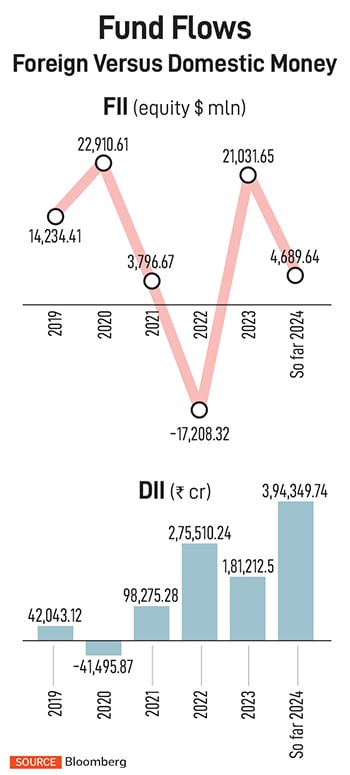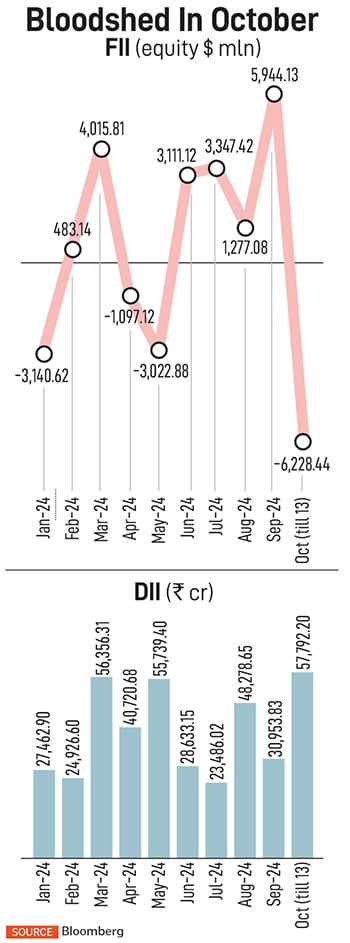
Indian stocks caught in a crossfire of Chinese boosters, West Asia flare-up
The exodus of foreign money out of Indian equities to China is threatening to topple the markets further
 The intensified geopolitical tensions in the Middle East and China’s monetary stimulus to boost its economy led to a massive correction of Indian markets in the first week of October
Illustration: Chaitanya Dinesh Surpur
The intensified geopolitical tensions in the Middle East and China’s monetary stimulus to boost its economy led to a massive correction of Indian markets in the first week of October
Illustration: Chaitanya Dinesh Surpur
The unfolding of a few historic events in Asia rocked the world in the last few weeks, jolting equity investors in India into panic and chaos. The optimistic outlook for India and growth plans for the Asian sub-continent quickly turned gloomy as investors rushed to dump Indian stocks to cut losses. What followed was a long tail of selling and more heavy selling of Indian stocks, taking the shine off from equity markets—once considered the jewel in the emerging markets pack.
The intensified geopolitical tensions in the Middle East and China’s monetary stimulus to boost its economy led to a massive correction of Indian markets in the first week of October, just after the benchmark indices Sensex and Nifty made new record highs in September. As investors continued to dump Indian equities, both the indices plunged over 5 percent in the first week of October from their respective record highs. What was projected as a north-bound bull market in India took a U-turn in a few days, as almost all domestic asset classes came tumbling.
A widely anticipated recovery in the Chinese economy aided by its government’s stimulus triggered the exodus of foreign funds from India to China. Amidst the chaos, the Indian currency weakened to its lowest level, breaching the ₹84-mark against the US dollar while the Federal Reserve lowered interest rates, sparking fears of recession.
 The fear of higher oil prices due to the Iran-Israel conflict also led to a rebalance in global portfolios, impacting India. China and Hong Kong stock markets have been on a tear, however, after the stimulus package was announced. Analysts still pin their hopes on India, calling the sharp corrections “long overdue” while the risks still persist.
The fear of higher oil prices due to the Iran-Israel conflict also led to a rebalance in global portfolios, impacting India. China and Hong Kong stock markets have been on a tear, however, after the stimulus package was announced. Analysts still pin their hopes on India, calling the sharp corrections “long overdue” while the risks still persist.
Chetan Seth, Asia-Pacific regional equity strategist, Nomura, thinks there is a rising risk of some near-term underperformance of India equities against the broader Asia-excluding Japan index due to a renewed interest in China equities on the back of the recently-announced monetary and liquidity measures. However, he does not consider it to be a long-lasting period of underperformance. Seth reasons that the structural story of India remains quite attractive, and if valuations revert to more palatable levels, foreign (and even domestic) investors would likely look to re-enter India. “MSCI India currently trades at a forward price-to-earnings (PE) of 24.1 times and should some of these concerns materialise, we think valuation levels going back to 21 times should become an attractive point for investors to start rebuilding positions in the market,” Seth adds.



 The PBoC declared interest rate cuts, a one trillion yuan liquidity injection and other steps to support the property and stock markets. China plans to issue special sovereign bonds worth about two trillion yuan ($284.43 billion) this year as part of a fresh fiscal stimulus, according to Reuters. Half of that would be used to help local governments tackle their debt problems, while the other half will subsidise purchases of home appliances and other goods as well as finance a monthly allowance of about 800 yuan, or $114, per child to all households with two or more children, says Reuters.
The PBoC declared interest rate cuts, a one trillion yuan liquidity injection and other steps to support the property and stock markets. China plans to issue special sovereign bonds worth about two trillion yuan ($284.43 billion) this year as part of a fresh fiscal stimulus, according to Reuters. Half of that would be used to help local governments tackle their debt problems, while the other half will subsidise purchases of home appliances and other goods as well as finance a monthly allowance of about 800 yuan, or $114, per child to all households with two or more children, says Reuters. The fund flow from India to China is mostly led by expectations of better returns at lower valuations. However, Seth feels that while China has pledged fiscal support, if it disappoints on announcement and execution, investors will likely be quick to pounce their money back into India equities Others concur. “The bull market is very much intact,” says Amar Ambani, executive director, Yes Securities. “For now, China’s monetary stimulus seems to have made its markets more appealing than India due to lower valuations. However, China faces deeper structural challenges that monetary and likely fiscal stimulus alone cannot resolve. In contrast, India has a stronger macroeconomic profile, which is unlikely to divert investment flows away from it. India’s weight in MSCI has been rising over the years and now stands at the second-highest place in the emerging markets basket,” he explains.
The fund flow from India to China is mostly led by expectations of better returns at lower valuations. However, Seth feels that while China has pledged fiscal support, if it disappoints on announcement and execution, investors will likely be quick to pounce their money back into India equities Others concur. “The bull market is very much intact,” says Amar Ambani, executive director, Yes Securities. “For now, China’s monetary stimulus seems to have made its markets more appealing than India due to lower valuations. However, China faces deeper structural challenges that monetary and likely fiscal stimulus alone cannot resolve. In contrast, India has a stronger macroeconomic profile, which is unlikely to divert investment flows away from it. India’s weight in MSCI has been rising over the years and now stands at the second-highest place in the emerging markets basket,” he explains.













